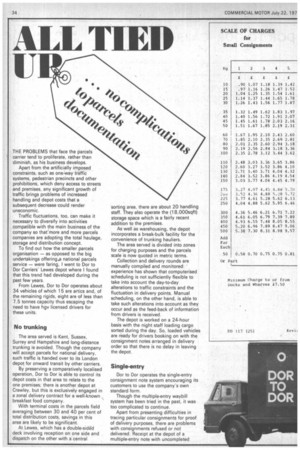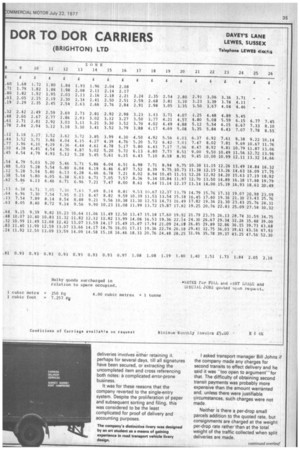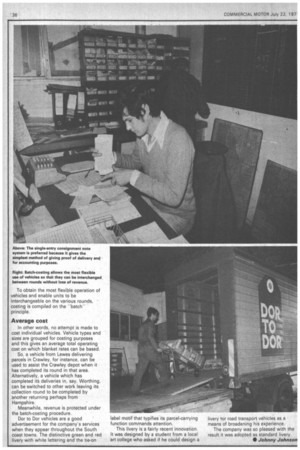ALL TIED
Page 36

Page 37

Page 38

If you've noticed an error in this article please click here to report it so we can fix it.
THE PROBLEMS that face the parcels carrier tend to proliferate, rather than diminish, as his business develops.
Apart from the artificially imposed constraints, such as one-way traffic systems, pedestrian precincts and other prohibitions, which deny access to streets and premises, any significant growth of traffic brings problems of increased handling and depot costs that a subsequent decrease could render uneconomic.
Traffic fluctuations, too, can make it necessary to diversify into activities compatible with the main business of the company so that more and more parcels companies are adopting the total haulage, storage and distribution concept.
To find out how the smaller parcels organisation as opposed to the big undertakings offering.a national parcels service were faring, I went to Dor to Dor Carriers' Lewes depot where I found that this trend had developed during the past few years.
From Lewes, Dor to Dor operates about 34 vehicles of which 15 are artics and, of the remaining rigids, eight are of less than 7.5 tonnes capacity thus escaping the need to have hgv licensed drivers for these units.
No trunking
The area served is Kent, Sussex, Surrey and Hampshire and long-distance trunking is-avoided. Though the company will accept parcels for national delivery, such traffic is handed over to its London depot for onward transit by other carriers.
By preserving a comparatively localised operation, Dor to Dor is able to control its depot costs in that area to relate to the one premises; there is another depot at Crawley, but this is exclusively engaged in a zonal delivery contract for a well-known .. breakfast food company.
With terminal costs in the parcels field averaging between 30 and 40 per cent of total distribution costs, savings in this area are likely to be significant.
At Lewes, which has a double-sided deck involving reception on one side and dispatch on the other with a central sorting area, there are about 20 handling staff. They also operate the (18,000sqft) storage space which is a fairly recent addition to the premises.
As well as warehousing, the depot incorporates a break-bulk facility for the convenience of trunking hauliers.
The area served is divided into zones for charging purposes and the parcels scale is now quoted in metric terms.
Collection and delivery rounds are manually compiled and monitored: ' experience has shown that computerised scheduling is not sufficiently flexible to take into account the day-to-day alterations to traffic constraints and the fluctuation in delivery points. Manual scheduling, on the other hand, is able to take such alterations into account as they occur and as the feed-back of information from drivers is received.
The depot is worked on a 24-hour basis with the night staff loading cargo sorted during the day. So, loaded vehicles are ready for drivers booking on with the consignment notes arranged in delivery order so that there is no delay in leaving the depot.
Single-entry
Dor to Dor operates the single-entry consignment note system encouraging its customers to use the company's own standard form.
Though the multiple-entry waybill system has been tried in the past, it was too complicated to continue.
Apart from presenting difficulties in tracing particular consignments for proof of delivery purposes, there are problems with consignments refused or not delivered. Receipt at the depot of a multiple-entry note with uncompleted
deliveries involves either retaining a, perhapsforseveraldays, till all signatures have been secured, or extracting the uncompleted item and cross referencing both notes: a complicated error-prone business.
htvvasforthese reasons that the company reverted to the single-entry system. Despite the proliferation of paper and subsequent sorting and filing, this was considered to be the least complicated for proof of delivery and accounting purposes.
The company's distinctive livery was designed by an art student as a means of gaining experience in road transport vehicle livery design.
I asked transport manager Bill Johns if the company made any charges for second transits to effect delivery and he said it was -too open to argument' for that. The difficulty of obtaining second transit payments was probably more expensive than the amount warranted and, unless there were justifiable circumstances, such charges were not made. . .
Neither is there a per-drop small parcels addition to the quoted rate, but consignments are charged at the weight per-drop rate rather than at the total weight of the traffic collected when split deliveries are made.
To obtain the most flexible operation of vehicles and enable units to be interchangeable on the various rounds, costing is compiled on the -batch" principle.
Average cost
In other words, no attempt is made to cost individual vehicles. Vehicle types and sizes are grouped for costing purposes and this gives an average total operating cost on which blanket rates can be based.
So, a vehicle from Lewes delivering parcels in Crawley, for instance, can be used to assist the Crawley depot when it has completed its round in that area. Alternatively, a vehicle which has completed its deliveries in, say, Worthing, can be switched to other work leaving its collection round to be completed by another returning perhaps from Hampshire.
Meanwhile, revenue is protected under the batch-costing procedure.
Dor to Dor vehicles are a good advertisement for the company's services when they appear throughout the South coast towns. The distinctive green and red livery with white lettering and the tie-on 'label motif that typifies itsparcel-carrying function commands attention.
This livery is a fairly recent innovation. It was designed by a student from a local art college who asked if he could design a livery tor road transport vehicles as a means of broadening his experience.
The company was so pleased with the result it was adopted as standard livery.
• Johnny Johnson




























































































